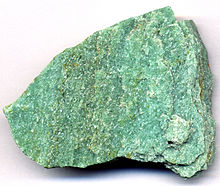Johann Nepomuk von Fuchs
Johann Nepomuk Fuchs , only from 1854 von Fuchs (born May 15, 1774 in Mattenzell in the municipality of Zell near Falkenstein , Cham district , Upper Palatinate , Bavaria ; † March 5, 1856 in Munich ), was a German chemist and mineralogist , royal Bavarian privy councilor and Oberbergrat.
Life
Fuchs was the son of Georg Fux from Mattenzell, mentioned in 1774 in Martinsneukirchen near Falkenstein (Bavaria).
In 1807 Johann Nepomuk Fuchs became professor of chemistry and mineralogy at the University of Landshut , and in 1823 curator of the mineralogical collections in Munich . In 1854 he was professor of mineralogy at the University of Munich .
In 1846 he founded together with Josef Schlotthauer the Stereochromie .
In 1853 Fuchs received the Bavarian Maximilian Order for Science and Art and was raised to the Bavarian hereditary nobility on December 8, 1854 in Munich with entry in the nobility register on January 12, 1855. From 1823 he was a full member of the Bavarian Academy of Sciences . In 1834 he was accepted as a corresponding member of the Prussian Academy of Sciences . In 1846 he was elected a member of the Leopoldina .
Johann Nepomuk Fuchs is considered to be the first to describe the minerals mesolite and scolezite (1813 together with Gehlen ), gehlenite (1815), wagnerite (1821) and triphylene (1834). According to him, which is muscovite - variety "Fuchsite" named. After von Helmond discovered the more easily soluble moisture in pebbles in 1640 , the so-called water glass was first manufactured by Fuchs in 1818.
During his research on the aqueous solutions of water glass , Fuchs was also able to determine that the silica precipitating from these solutions is initially in amorphous form before it undergoes an irreversible transition to crystalline form. In his "Theories of the Earth" he postulated that analogous processes could also have taken place in nature, whereby a mechanism is possible that allows the formation of silicate minerals and rocks from an aqueous phase and without the participation of a melt (and the high temperatures required for this ) would allow. With these considerations, Fuchs became a founder of neo-septunism .
tomb
The grave of Johann Fuchs is in the old southern cemetery in Munich (grave field 41 - row 1 - place 26/27) location .
Works
- About the theories of the earth, the amorphism of solid bodies and the mutual influence of chemistry and mineralogy : together with a short list of the contents of all other writings and essays by the author for his 70th birthday party published by some friends / by JN Fuchs. - Munich: Fleischmann, 1844. Digitized edition of the University and State Library in Düsseldorf - First publication of “Theories of the Earth” in 1838
literature
- Genealogical manual of the nobility , Adelslexikon Volume III, Volume 61 of the complete series, CA Starke Verlag, Limburg (Lahn) 1975, ISSN 0435-2408 .
- Wilhelm Prandtl: German chemists in the first half of the nineteenth century , Verlag Chemie, Weinheim (Bergstrasse) 1956.
- Wilhelm von Gümbel : Fuchs, Johann Nepomuk von . In: Allgemeine Deutsche Biographie (ADB). Volume 8, Duncker & Humblot, Leipzig 1878, pp. 165-168.
- Rudolph Zaunick: Fuchs, Johann Nepomuk von. In: New German Biography (NDB). Volume 5, Duncker & Humblot, Berlin 1961, ISBN 3-428-00186-9 , p. 680 ( digitized version ).
- Bernhard Fritscher : Johann Nepomuk Fuchs' "Theory of the Earth". In: Sudhoffs Archiv 71, 1987, 2, pp. 141–156.
Web links
- Literature list in the online catalog of the Berlin State Library
- The estate in the Bavarian State Library
- Website Mittelbayrische Zeitung - The big son of the municipality of Zell
- Portrait in the portrait collection of the Munich City Museum
- Mineral Lexicon - Fuchsite
- Mineral Atlas - Fuchsite
Individual evidence
- ↑ Hans Körner: "The Bavarian Maximilian Order for Science and Art and its Members" in: Journal for Bavarian State History, Vol. 47 (1984), pp. 299–398.
- ^ Members of the previous academies. Johann Nepomuk von Fuchs. Berlin-Brandenburg Academy of Sciences , accessed on March 26, 2015 .
- ^ Member entry by Johann Nepomuk von Fuchs at the German Academy of Natural Scientists Leopoldina , accessed on December 10, 2015.
- ^ Zeno.org: pebble moisture
- ↑ Fraunhofer IRB: Chemistry and properties of water glass ( Memento from July 20, 2012 in the web archive archive.today )
- ↑ H. Hagn: The development of paleontology and geology from the beginning to the 19th century . In: Communications from the Bavarian State Collection for Paleontology and Historical Geology . tape 35 , 1995, pp. 217-237 .
- ^ Johann Nepomuk Fuchs: Theories of the Earth (1838). In: Collected writings of Johann Nepomuk von Fuchs. Edited by the Central Administrative Committee of the Polytechnic Association for the Kingdom of Bavaria, Munich 1956.
| personal data | |
|---|---|
| SURNAME | Fuchs, Johann Nepomuk von |
| ALTERNATIVE NAMES | Fuchs, Johann Nepomuk |
| BRIEF DESCRIPTION | German chemist and mineralogist |
| DATE OF BIRTH | May 15, 1774 |
| PLACE OF BIRTH | Mattenzell |
| DATE OF DEATH | March 5, 1856 |
| Place of death | Munich |


